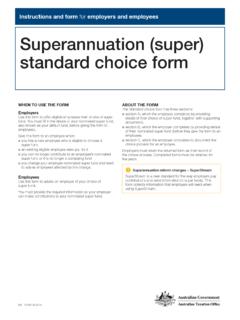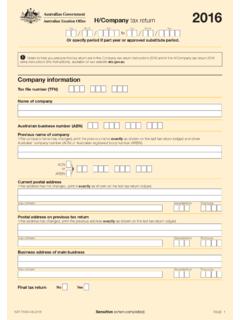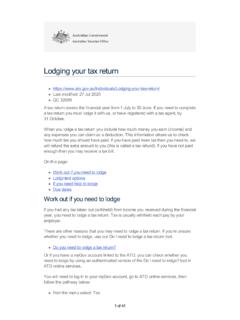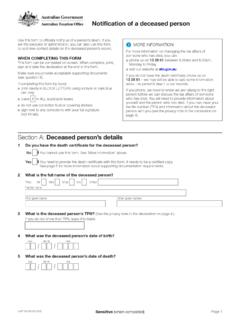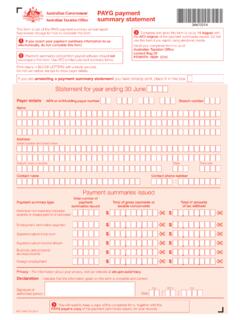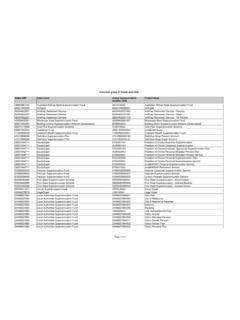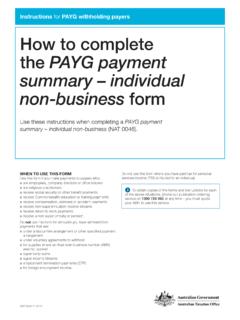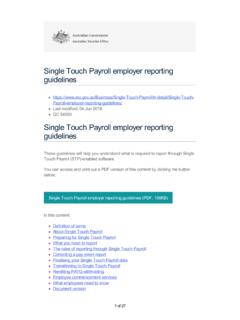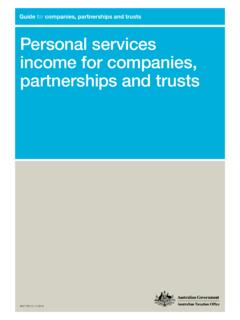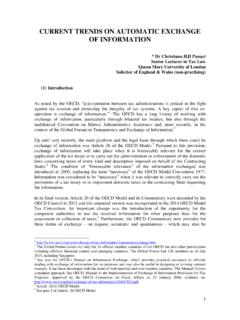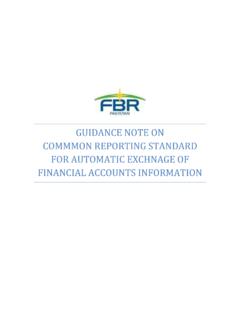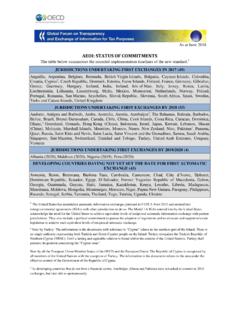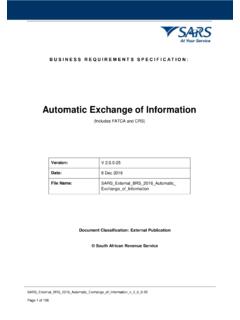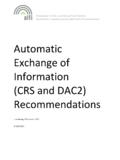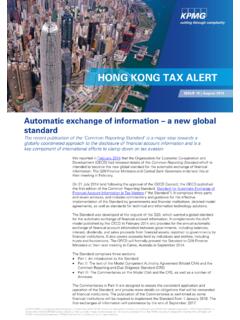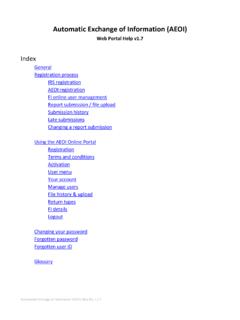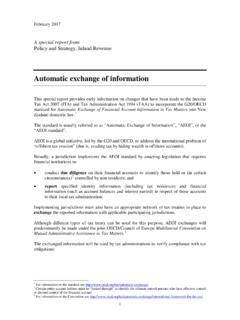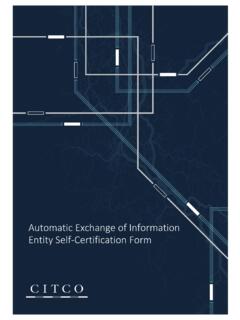Transcription of Automatic exchange of information - CRS and Automatic ...
1 Automatic exchange of information - CRS modified: 21 Oct 2020QC 48683 Automatic exchange of information guidance CRS and FATCAThis information is intended to help you understand your obligations underAustralia s participation in Automatic exchange of information (AEOI) regimesconcerning the Automatic exchange of financial account information with regimes are known as the Foreign Account Tax Compliance Act (FATCA) inthe case of exchange by Australia with the United States of America ( ) and theCommon Reporting Standard CRS or the Standard, as the context requires inthe case of exchange by Australia with other countries that have implemented guidance explains AEOI obligations from 1 July 2017, the date the CRS startedoperation in Australia.
2 Unless otherwise noted, the explanations in this guidancecover both FATCA and CRS from 1 July are some variations in terminology between FATCA and CRS. When thecontext requires, the following CRS terms should be read interchangeably withFATCA terms in this guidanceCRS and FATCA termsCRSFATCAR eporting Financial Institution(RFI)Reporting Australian Financial Institution1 of 94 Non-Reporting FinancialInstitutionNon-Reporting Australian FinancialInstitutionNon-Financial Entity (NFE)Non-Financial Foreign Entity (NFFE)Reportable PersonSpecified PersonReportable Reportable AccountDollar values stated in the guidance should be read for CRS purposes as referringto either Australian dollars or dollars according to the election by the relevantRFI, as permitted by Australian law for the CRS.
3 For FATCA, the dollar values referto dollars to calendar year in this guidance should be taken to include, for CRSpurposes, the initial reporting period of 1 July 2017 to 31 December guidance provides general help and does not cover all possibilities. If youfollow our information in this guidance and it turns out to be incorrect, or it ismisleading and you make a mistake as a result, we must still apply the law correctlybut we will not charge you a guidance material will be updated from time to IntroductionOn this Legislative CRS the 'wider approach' Implementation Relevance of CRS Commentary to Structure of this BackgroundIn 2010, the enacted the FATCA provisions which are aimed at reducing taxevasion by citizens and entities.
4 FATCA is a unilateral anti-tax evasion regimeenacted by the Congress as part of the Hiring Incentives to RestoreEmployment Act 2010. FATCA is aimed at detecting taxpayers who useaccounts with offshore financial institutions to conceal income and assets from theInternal Revenue Service (IRS). The substantive FATCA requirements for financialinstitutions generally started on 1 July that many countries domestic laws would otherwise prevent foreignfinancial institutions from fully complying with FATCA, the developed anintergovernmental agreement (commonly known as an IGA) approach. Thisapproach manages legal impediments, simplifies practical implementation, and2 of 94reduces compliance costs for relevant financial institutions.
5 On 28 April 2014, theTreasurer, on behalf of the Australian Government, and the Ambassador toAustralia, on behalf of the Government, signed the Agreement between theGovernment of Australia and the Government of the United States of America toImprove International Tax Compliance and to Implement FATCA (FATCAA greement).The implementation of Australia s obligations under the FATCA Agreement wasinitiated with the passage of the Tax Laws Amendment (Implementation of theFATCA Agreement) Act 2014, which took effect on 1 July evasion is a global problem and international cooperation and sharing of highquality, predictable information between revenue authorities will help them ensurecompliance with local tax laws.
6 Starting in 2012 international interest focused on theopportunities provided by Automatic exchange of 6 September 2013 the G20 Leaders committed to Automatic exchange ofinformation as the new global standard and fully supported the OECD work withG20 countries, which aimed to present a single global standard in 2014. In February2014, the G20 Finance Ministers and Central Bank Governors endorsed the CRSas the mechanism for Automatic exchange of tax information between CRS was endorsed by G20 Leaders at their meeting on 15 and 16 November2014. So far, more than 100 jurisdictions have committed to its implementation. TheCRS, with a view to maximising efficiency and reducing cost for financial institutions,draws extensively on the IGA approach to implementing FATCA.
7 While the IGAapproach to FATCA reporting does deviate in certain aspects from the CRS, thedifferences are driven by the multilateral nature of the CRS system and other aspects, in particular taxation based on citizenship and the presence of asignificant and comprehensive FATCA withholding can be different legal bases for the Automatic exchange of information . Theseinclude Australia s bilateral tax treaties or the Convention on Mutual AdministrativeAssistance in Tax Matters (the Convention). The latter is a multilateral agreement tofacilitate international cooperation among tax authorities, improve their ability totackle tax evasion and avoidance, and ensure full implementation of their nationaltax laws while respecting the fundamental rights of taxpayers.
8 The Conventionprovides for all forms of administrative cooperation and contains strict rules onconfidentiality and proper use of information . Australia signed the amendedConvention in exchange under the Convention requires an administrative agreementbetween the ATO and other countries tax authorities. On 3 June 2015, Australiasigned the Multilateral Competent Authority Agreement on Automatic exchange ofFinancial Account information (MCAA), which is based on Article 6 of theConvention. This agreement facilitates the implementation of the CRS on amultilateral basis and has so far been signed by more than 100 jurisdictions. TheMCAA provides a framework for the bilateral exchange of information with of Legislative implementationCRS obligations are imposed on Australian financial institutions (AFIs) through theoperation of Subdivision 396-C of Schedule 1 to the Taxation AdministrationAct 1953 (TAA 1953).
9 The CRS implementing legislation requires that the CRS must be appliedconsistently with the CRS also:OECD iLibrary for Common Reporting StandardCommentaries on the Common Reporting Standard The OECD also published frequently asked questions (FAQs) and animplementation handbook to assist in understanding CRS obligations, although thismaterial must be considered as secondary to the legislation, the CRS and guidance is intended to assist in the application of the CRS, its Commentaryand the implementing legislation and does not substitute or reduce the need toapply CRS requirements consistently with the same. The CRS legislation allowsRFIs to make any of the elections available within the CRS.
10 Examples of duediligence elections are described in Alternative procedures and obligations are imposed on AFIs through the operation of Subdivision 396-Aof Schedule 1 to the TAA FATCA implementing legislation permits RFIs to make any of the electionsallowed, or contemplated, by the FATCA Agreement. The FATCA Agreementpermits Australia to allow RFIs to elect to apply alternative definitions as well asalternative procedures to those specified in the Agreement. Consequently, an AFImay elect to use the definitions in FATCA Regulations where a term is definedin the FATCA Agreement and may use alternative procedures provided in theRegulations.
